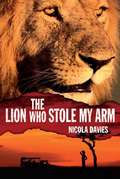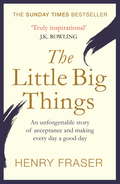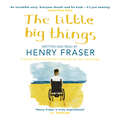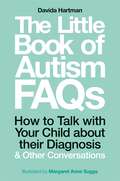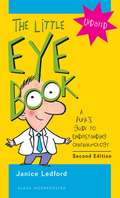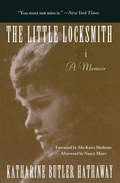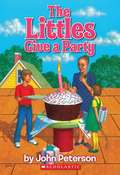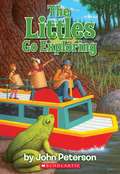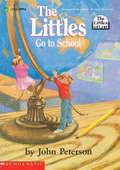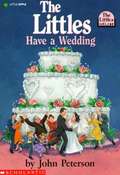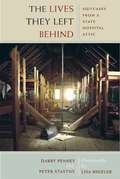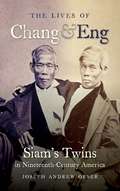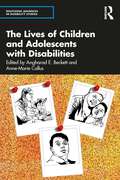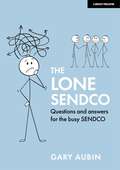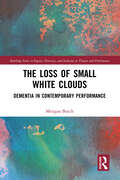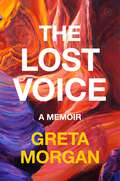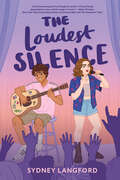- Table View
- List View
The Lion Who Stole My Arm (Heroes of the Wild)
by Nicola DaviesZoologist Nicola Davies presents an illustrated novel for young readers that proves you don’t need two arms to be strong. Pedru has always wanted to be a great hunter like his father, but after a lion takes his arm, he worries that he’ll always be the crippled boy instead. Pedru longs to kill the lion that mauled him and strengthens himself to be ready for the hunt. But when the opportunity arises, will Pedru have the strength to turn his back on revenge? Zoologist Nicola Davies perfectly merges a heart-pounding adventure with an important message about conservation, and Annabel Wright’s gorgeous black-and-white illustrations bring Pedru’s story to life.
The Little Big Things: The Inspirational Memoir of the Year
by Henry FraserTHE SUNDAY TIMES BESTSELLER"Henry Fraser is one of the most remarkable people I've ever met" J.K. Rowling"What a story of transformation, inner power and inspiration" Jonny Wilkinson The memoir of the year by Henry Fraser, motivational speaker and mouth artist with a foreword by J.K. Rowling.Being challenged in life is inevitable, but being defeated is optional...Henry Fraser was 17 years old when a tragic accident severely crushed his spinal cord. Paralysed from the shoulders down, he has conquered unimaginable difficulty to embrace life and a new way of living. Through challenging adversity, he has found the opportunity to grow and inspire others.This book combines his wisdom and insight into finding the gifts in life's challenges, and will resonate with anyone facing an obstacle, no matter how big or small. It includes Henry's thoughts on how to look at the right things and avoid the wrong, finding progress in whatever you do, and acknowledging and accepting the darkness when it comes. Right at the heart of Henry's inspiring philosophy is his belief that every day is a good day.
The Little Big Things: The Inspirational Memoir of the Year
by Henry FraserTHE SUNDAY TIMES BESTSELLER"Henry Fraser is one of the most remarkable people I've ever met" J.K. Rowling"What a story of transformation, inner power and inspiration" Jonny Wilkinson The memoir of the year by Henry Fraser, motivational speaker and mouth artist with a foreword by J.K. Rowling.Being challenged in life is inevitable, but being defeated is optional...Henry Fraser was 17 years old when a tragic accident severely crushed his spinal cord. Paralysed from the shoulders down, he has conquered unimaginable difficulty to embrace life and a new way of living. Through challenging adversity, he has found the opportunity to grow and inspire others.This book combines his wisdom and insight into finding the gifts in life's challenges, and will resonate with anyone facing an obstacle, no matter how big or small. It includes Henry's thoughts on how to look at the right things and avoid the wrong, finding progress in whatever you do, and acknowledging and accepting the darkness when it comes. Right at the heart of Henry's inspiring philosophy is his belief that every day is a good day.
The Little Big Things: The Inspirational Memoir of the Year
by Henry FraserA short, inspirational read from Henry Fraser, a young quadriplegic motivational speaker and artist.Henry Fraser was a 17-year old sports enthusiast and senior prefect when he broke his spinal cord and was left paralysed from the shoulders down. Life as he knew it was over and yet, through extraordinary determination and a positive attitude, he has forged a successful career as an inspirational speaker and an artist. He chose survival over defeat, and transformed unimaginable difficulty into an opportunity to grow and inspire others. This book will combine his wisdom and insight into accepting life's challenges with positivity and hope, and will resonate with anyone facing an obstacle, no matter how big or small. It includes Henry's thoughts on how to look at the right things and avoid the wrong things, looking for progress in whatever you do, and acknowledging and accepting the darkness when it comes. Right at the heart of Henry's inspiring philosophy is his belief that every day is a good day.Written and Read by Henry Fraser(p) 2017 Orion Publishing Group
The Little Book of Autism FAQs: How to Talk with Your Child about their Diagnosis and Other Conversations
by Davida HartmanEmpowering and practical, this guide is the perfect companion for parents who are finding it difficult to tell their children about their autism diagnosis. It provides a realistic yet uplifting approach to autism, treating it not as a disability but as a difference.Not telling children about their autism diagnosis can have a significant negative impact on their mental health; by equipping parents with a language of positivity around autism, the book will make a difference to many children on the spectrum. It advises on how and when to talk to autistic children with both high and low care needs, and provides guidance on supporting children's relationships with peers at school, as well as how to broach the conversation with the child's siblings.Concise and easy to read, The Little Book of Autism FAQs answers parents' questions with accessible language, preparing them to approach this difficult conversation in a constructive manner.
The Little Eye Book: A Pupil's Guide to Understanding Ophthalmology (2nd edition)
by Janice K. LedfordThis little book has much information for the non-physician, including what signs to look for, how to determine an emergency and how some medications affect the eye. The superscripted numbers indicate references at the end of the chapters.
The Little House That Cares
by Marty LanserThis book contains candid stories of how blindness has affected the lives of individuals who sought help at the Vision Impaired Persons Support Center in Modesto, CA. Some were born blind, some lost their vision later in life, and some took the responsibility for caring for their visually impaired loved one. Your heart will be touched, and your life will be encouraged by each and every story.
The Little Locksmith: A Memoir
by Katharine Butler HathawayFirst published in 1942 and reprinted here by the Feminist Press, this is the deeply honest memoir of Katharine Butler, who was disabled from childhood due to tuberculosis of the spine. Butler describes her bedridden childhood and her emergence as a teenager with a notably different-looking body. She writes openly of her longing for sexual love and her sense that it was forever denied to her because of her difference. Much of the book concerns the author's renovation of and hopes for a house in Castine on the coast of Maine, which she dreamed would become a house for children, artists, and lovers. Nancy Mairs' afterword provides fascinating information about the author's life.
The Little Locksmith: A Memoir (Physically Handicapped In Society Ser.)
by Katharine Butler HathawayThis early 20th century memoir of a woman&’s faith in the face of debilitating disease is a &“remarkably un-self-pitying book remains poignant and truthful&” (Publishers Weekly). &“You must not miss it . . . It is the kind of book that cannot come into being without great living and great suffering and a rare spirit behind it.&” —The New York Times In 1895, a specialist straps five-year-old Katharine Hathaway, then suffering from spinal tuberculosis, to a board with halters and pulleys in a failed attempt to prevent her from becoming a &“hunchback&” like the &“little locksmith&” who does odd jobs at her family&’s home. Forced to endure her confinement for ten years, Katharine remains immobile until age fifteen, only to find that none of it has prevented her from developing a deformity of her own. The Little Locksmith charts Katharine&’s struggle to transcend physical limitations and embrace her life, her body, and herself. Her spirit and courage prevail as she expands her world far beyond the boundaries prescribed by her family and society: she attends Radcliffe College, forms deep friendships, begins to write, and in 1921, purchases a house of her own that she fashions into a space for guests, lovers, and artists. Revealing and inspirational, The Little Locksmith stands as a testimony to Katharine&’s aspirations and desires—for independence, love, and the pursuit of her art. &“A powerful revelation of spiritual truth&” —The Boston Globe &“Katharine Butler Hathaway . . . was the kind of heroine whose deeds are rarely chronicled . . . [She took] a life which fate had cast in the mold of a frightful tragedy and redesign[ed] it into a quiet, modest work of art.&” —The New Yorker
The Littles Give a Party
by John PetersonIt's a dangerous life, being smaller than six inches tall so it's truly amazing that Granny will be turning eighty on her Fourth of July birthday. Instead of being excited about it, she's worried that she's too old and has stopped paying attention to anything. Tom and Lucy, her great grandchildren and their family think a big party will cheer her up. The trouble is, most of Granny's favorite people think they are too old to travel to the party and riding in Cousin Dinky's glider is too risky. The Little's have a long list of adventures ahead to pull off the party. They must rig up a swimming pool, smuggle hot dogs, and hardest of all, they have to sneak young Henry's toy airplane out of his room at night to fly the guests to the party. Except for having to hear Dinky's terrible singing, it's all worth it because Granny is so excited to see her friends. Bookshare has many more books about the family who uses thimbles for wastebaskets and finger puppets on cereal boxes for costumes. Some of the Little's books are: The Littles, The Littles Take a Trip, The Littles and the Surprise Thanksgiving Guests, The Littles to the Rescue, Tom Little's Halloween Scare, The Littles and the Trash Tinies, The Littles Go to School, The Littles Get Trapped, and The Littles and the Missing Cat.
The Littles Go Exploring
by John PetersonThe Littles venture into the land beyond the Dark Woods, an area unknown to small people. Reissue to celebrate the Littles' 25th anniversary.
The Littles Go to School
by John Peterson"I still don't see why I have to go," said Lucy. "But Lucy, it's fun," said Tom. "You get to see lots of the tiny kids from all over the Big Valley. We use the chalkboards. We read some of the textbooks the big kids use. There are maps and charts, and we live in dormitories in the walls of the classroom. You'll like it." Tom and Lucy are going to school! But an unexpected adventure in a gerbil cage gets them to school a little too early!
The Littles Have a Wedding
by John PetersonMeet the Littles, a family like any other but with a few tiny differences! They live in the walls of the Bigg family house where they get everything they need. In return they make sure the Bigg house is always in good repair. When Dinky comes home from his latest adventure, he's not alone. Della came back with him and they're going to be married! But a tiny person wedding takes a huge amount of preparation. The Littles need to get everything ready and travel to a neighboring house by the next day. Will they be ready in time?
The Lives They Left Behind
by Robert Whitaker Darby Penney Peter Stastny Lisa Rinzler"The Lives They Left Behind is a deeply moving testament to the human side of mental illness, and of the narrow margin which so often separates the sane from the mad. It is a remarkable portrait, too, of the life of a psychiatric asylum--the sort of community in which, for better and for worse, hundreds of thousands of people lived out their lives. Darby Penney and Peter Stastny's careful historical (almost archaeological) and biographical reconstructions give us unique insight into these lives which would otherwise be lost and, indeed, unimaginable to the rest of us."--Oliver Sacks, M.D., Professor of Neurology and Psychiatry, Columbia University Medical Center, Columbia University Artist, and author of Musicophilia "The haunting thing about the suitcase owners is that it's so easy to identify with them."--Newsweek "In their poignant detail the items helped rescue these individuals from the dark sprawl of anonymity."--The New York Times "[The authors] spent 10 years piecing together . . . the lives these patients lived before they were nightmarishly stripped of their identities."--Newsday More than four hundred abandoned suitcases filled with patients' belongings were found when Willard Psychiatric Center closed in 1995 after 125 years of operation. They are skillfully examined here and compared to the written record to create a moving--and devastating--group portrait of twentieth-century American psychiatric care.
The Lives They Left Behind: Suitcases from a State Hospital Attic
by Darby Penney Peter StastnyThis book grew out of ten years of research conducted by two journalists who discovered a trove of abandoned trunks and suitcases in an attic at Willard State Hospital in New York. Through extensive research they were able to reconstruct the histories of ten patients who were hospitalized at Willard during the years before deinstitutionalization. Through the microcosm of individual lives the authors humanize the tragedy of our treatment of people deemed to be mentally ill.
The Lives of Chang and Eng
by Joseph Andrew OrserConnected at the chest by a band of flesh, Chang and Eng Bunker toured the United States and the world from the 1820s to the 1870s, placing themselves and their extraordinary bodies on exhibit as "freaks of nature" and "Oriental curiosities." More famously known as the Siamese twins, they eventually settled in rural North Carolina, married two white sisters, became slave owners, and fathered twenty-one children between them. Though the brothers constantly professed their normality, they occupied a strange space in nineteenth-century America. They spoke English, attended church, became American citizens, and backed the Confederacy during the Civil War. Yet in life and death, the brothers were seen by most Americans as "monstrosities," an affront they were unable to escape.Joseph Andrew Orser chronicles the twins' history, their sometimes raucous journey through antebellum America, their domestic lives in North Carolina, and what their fame revealed about the changing racial and cultural landscape of the United States. More than a biography of the twins, the result is a study of nineteenth-century American culture and society through the prism of Chang and Eng that reveals how Americans projected onto the twins their own hopes and fears.
The Lives of Children and Adolescents with Disabilities (Routledge Advances in Disability Studies)
by Angharad E. BeckettThis book will be of interest to undergraduates, postgraduates and researchers in disability studies, childhood studies, medicine and health sciences, and sociology. It also provides insights that will be of use and value to professionals working with disabled children and adolescents in education, health and in disability-specific services. Opening with four narratives that offer the reader a window into the lived experience of disabled children, adolescents and their families, subsequent chapters explore a range of issues facing disabled children from early childhood through to late adolescence. Topics include family life, early intervention, inclusive and post-secondary education, the right to play, digital participation, the effects of labelling and matters relating to agency and sexuality. With chapters discussing research from Australia, Canada, Ireland, Italy, Malta, Mexico, New Zealand, Sweden and the UK amongst others, this book: • contributes to the existing body of knowledge about the lives of disabled children and adolescents, with a focus on socially created disabling factors; • provides the reader with analysis of issues affecting disabled children and adolescents according to different conceptual frameworks, national contexts and with regard to different types of impairments/disabilities; • highlights the main issues that confront disabled children and adolescents, their families and their allies in the early twenty-first century;• highlights the importance of actively listening to the perspectives of disabled children and adolescents. It provides a rich source of knowledge and information about the lives of disabled children and adolescents, and a variety of perspectives on how their lives are affected by material and non-material factors, social structures and cultural constructions.
The Lone SENDCO: Questions and answers for the busy SENDCO
by Gary AubinThe SENDCO role can feel quite isolating. SENDCOs know more than anyone in their setting about SEND, so who do they go to when they need support? Especially when new to the role, who do you turn to when tackling a problem or looking for inspiration? The Lone SENDCO answers over 300 questions that SENDCOs grapple with, whether experienced or new: How should outcomes be worded? Do I get longer to respond if I receive a consultation in the holidays? How shall I structure my inclusion department? How do I assess SEND for a child with EAL? How should I be working with my school’s Careers Officer? How do I motivate disengaged learners? What do Ofsted look for in an inspection?Split helpfully into easily-workable sections, this reference book can be picked up and dipped into, whatever the priority. Whether it’s organising an annual review for the first time, taking your partnership with parents to the next level or linking your work in SEND to cognitive science, The Lone SENDCO tackles the questions you have and the answers you need.Sections include: EHCPs and annual reviews, working with parents/carers, statutory compliance and legislation, strategic thinking as a SENDCO, identification and assessment of SEND, supporting transition for pupils, working with pupils, Ofsted developing my knowledge as a SENDCO, funding for SEND, teaching and learning, exam access arrangements, understanding data, tracking progress, managing a SEND register, understanding the SENDCO role, challenging decisions around placement and provision, CPD as a SENDCO, SEND as a whole-school issue, working with TAs, working with external partners, provision mapping, interventions, troubleshooting and a guide to types of need.
The Lone SENDCO: Questions and answers for the busy SENDCO
by Gary AubinThe SENDCO role can feel quite isolating. SENDCOs know more than anyone in their setting about SEND, so who do they go to when they need support? Especially when new to the role, who do you turn to when tackling a problem or looking for inspiration? The Lone SENDCO answers over 300 questions that SENDCOs grapple with, whether experienced or new: How should outcomes be worded? Do I get longer to respond if I receive a consultation in the holidays? How shall I structure my inclusion department? How do I assess SEND for a child with EAL? How should I be working with my school’s Careers Officer? How do I motivate disengaged learners? What do Ofsted look for in an inspection?Split helpfully into easily-workable sections, this reference book can be picked up and dipped into, whatever the priority. Whether it’s organising an annual review for the first time, taking your partnership with parents to the next level or linking your work in SEND to cognitive science, The Lone SENDCO tackles the questions you have and the answers you need.Sections include: EHCPs and annual reviews, working with parents/carers, statutory compliance and legislation, strategic thinking as a SENDCO, identification and assessment of SEND, supporting transition for pupils, working with pupils, Ofsted developing my knowledge as a SENDCO, funding for SEND, teaching and learning, exam access arrangements, understanding data, tracking progress, managing a SEND register, understanding the SENDCO role, challenging decisions around placement and provision, CPD as a SENDCO, SEND as a whole-school issue, working with TAs, working with external partners, provision mapping, interventions, troubleshooting and a guide to types of need.
The Loss of Small White Clouds: Dementia in Contemporary Performance (Routledge Series in Equity, Diversity, and Inclusion in Theatre and Performance)
by Morgan BatchThis volume seeks to instigate a discussion about dementia in theatre. The discussions in this book borrow from the literature on dementia’s representation in other artforms, while reflecting on theatre’s unique capacity to incorporate multiple artforms in a live context (hypermediacy). The author examines constructions of diegesis and the use of various performance tools, including physical theatre, puppetry, and postdramatic performance. She discusses stage representations of interior experiences of dementia; selfhood in dementia; the demarcation of those with dementia from those without; endings, erasure, and the pursuit of catharsis; placelessness and disruptions of traditional dramatic constructions of time; and ultimately, performances creatively led by people with dementia. The book traces patterns of narrativisation on the stage—including common dramaturgical forms, settings, and character relationships—as well as examples that transcend mainstream representation. This book is important reading for theatre and performance students, scholars, and practitioners, as well as cultural studies writers engaged in research about narratives of dementia.
The Lost Voice: A Memoir
by Greta MorganA poignant, tenacious memoir by musician Greta Morgan chronicling how she rediscovered her artistic voice after losing her ability to sing.In 2019, Greta Morgan was on the rise. She was a touring member of Vampire Weekend, performed with Jenny Lewis, and garnered critical acclaim with her own musical projects. But in March 2020, after contracting Covid-19, she was diagnosed with spasmodic dysphonia, a neurological disorder with no known cure that left her unable to sing. Her once crystalline voice now reduced to a hush, she saw her career come to an abrupt standstill.Beyond the physical ramifications, what does it mean to cultivate a true voice? Morgan’s loss launches her into a journey of grief and self-discovery, forcing her to broaden her artistic horizons and reconstruct her sense of self. Her narrative takes us on a whirlwind tour of music studios, band buses, and celebrity-filled backstage parties, but it also takes us to the red canyons of Utah and the spacious wilderness of the American Southwest. In these vast landscapes, Morgan finds unexpected community. In the silence, she learns how to listen to parts of herself she has neglected.Questioning the purpose of creativity and what defines artistic passion, The Lost Voice is a raw and intimate portrait of grief, self-discovery, and the choice to keep living and creating.
The Loudest Silence
by Sydney LangfordTwo disabled queer teens find belonging in this poignant platonic love story about singing, signing, and solidarity.Casey Kowalski once dreamed of becoming a professional singer. Then the universe threw her a life-altering curveball—sudden, permanent, and profound hearing loss—just before her family&’s move from Portland to Miami. Now, she&’s learning to navigate the world as a Deaf-Hard of Hearing person while trying to conceal her hearing loss from her new schoolmates. Hayden González-Rossi is also keeping secrets. Three generations of González men have risen to stardom on the soccer field, and Hayden knows his family expects him to follow in their footsteps, but he wants to quit soccer and pursue a career on Broadway. If only his Generalized Anxiety Disorder didn&’t send him into a debilitating spiral over the thought of telling the truth.Casey and Hayden are both determined to hide who they really are. But when they cross paths at school, they bond over their shared love of music and their mutual feeling that they don&’t belong, and the secrets come spilling out. Their friendship is the beating heart of this dual-perspective story featuring thoughtful disability representation, nuanced queer identities, and a lovably quirky supporting cast.
The Loving Push: How Parents and Professionals Can Help Spectrum Kids Become Successful Adults
by Temple Grandin Debra MooreThe purpose of this book is to help parents let go and give careful, loving pushes to get their child to try new things. Temple Grandin, Debra Moore spell out which steps you can take to restore your child’s hope and motivation--and what you must avoid.
The Luckiest Girl in the World
by Steven LevenkronKatie is a promising figure skater whose divorced mother drives her relentlessly to perfect her skills, at almost any expense. What her mother and coach don't know, but her English teacher begins to figure out, is that when Katie gets to an emotional edge, she hides and cuts herself; the pain and blood help focus her mind. Not until she goes over that edge one day at school and begins slamming her locker door on her hand and then banging her head on the wall does she begin to get the professional help she needs. After a couple of false starts, she finds a psychiatrist experienced in working with teens in trouble who enables her to tell truths she hasn't for years been able to admit to herself or speak of to anyone else. Her mother resists other adults' help and almost succeeds in getting her out of therapy, especially group therapy with girls her mother labels "delinquents." But Katie finally manages to make some choices against her mother's wishes--an immense step out of the depths of years of co-dependence. As the story ends, she has come to realize the girls in the group are capable of being real friends--something she hasn't had for a long while--and she is capable of making choices toward her own healing, the first of which is to seek and accept real help and to distinguish it from pleasing adults who are using her to assuage their own pain.
